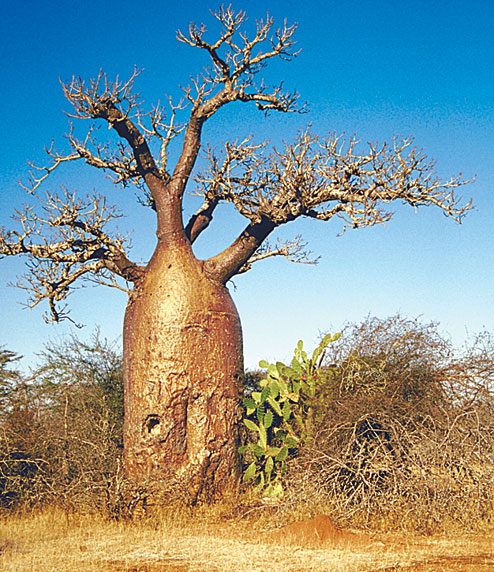
1 Baobab
Did the devil uproot this tree and place it upside down? Do spirits possess it at night? Why do bats flock to its flowers? The African-origin Baobab has many myths attached to it, all attributed to its bizarre appearance.
The tree looks out of proportion since its girth can be up to 16m as opposed to a height of 16-20m. When the tree is bare of leaves, the trunk looks quite grotesque and the African tribes believe a devil uprooted the tree and replanted it upside down. They say spirits frequent it too since it attracts bats at night. In reality, the bats come to drink nectar from its flowers, that strangely open up at night.
The Baobab is also called the Monkey Bread Tree because monkeys are fond of its fruit. Its scientific name is Adansonia digitata, in which the word digitata is a reference to the finger-like shape of its leaves. The word digitus means finger in Latin.
The tree is endemic to Africa and is one of the longest living trees there.

2 Krishna Vat
The leaves of this plant form a cup-shaped pocket at its base and the peculiar shape has given rise to various legends. Lord Krishna’s foster mother Yashoda is said to have used this leaf to feed him milk when he was a baby and hence the name Krishna Vat. The tree is also called Makhan Katori (butter bowl) as it is said that Yashodha would store butter for Krishna in the leaf’s pocket.
In the early 1890s, David Prain, the then director of Royal Botanic Garden, Howrah (now known as Calcutta Botanical Garden) noticed this plant and sent a specimen to expert botanist C. De Condole in Geneva, while sharing the legend of Krishna with him.
Upon examining the plant, Condole said it was a natural new specimen and named the plant Ficus Krishnae. However, after 1930, further examination revealed that the tree was not a separate species but a bud sport of the ordinary Banyan and renamed it Ficus Benghalensis Var Krishnae.

3 Naglingam
The flowers of this tree form a curious arrangement. They spread over the pistil as if a snake has spread its hood over a Shivalinga. This is why the tree is called Naglingam.
The tree has a peculiar behaviour in that it sheds all its leaves without warning and within seven to 10 days, a light green tuft of leaves appear at the top of the branches. It has been observed in industrial areas that if the Naglingam comes in contact with gases like chlorine, it defoliates completely within two hours and sprouts afresh within 24 hours. This is why it is also called Pollution Indicator tree.
It is also known as Canon Ball Tree as that’s what its fruits look like. Bats love these fruits but they are unappetising to people because of a strong smell. Its flowers are sweet-scented and have a pleasing combination of colours like pink and purple, white and yellow etc.
The tree traces its origin to South America.

4 Pakhi Lata
The flower of this tree resembles a long-tailed bird. Often brown-with tiny spots, it looks like the ghughu bird and is often called Ghughu Lata too.
It is a quick-growing climber suitable for growing on walls and trellis and flowers from March to May and again from October to December. Its leaves are rounded and kidney-shaped, pale green above and glaucous beneath.
Scientifically known as Aristolochia Ringens, it grows in tropical and subtropical regions and originated in South America. India too has several species of this climber.

5 Jabuticaba
In peak season, one can barely see the trunk of this Brazilian tree for it gets covered by its big, dark fruits. Fruits of the Jabuticaba grow not just on its branches but all over its trunk. Its flowers too, white in colour, grow directly from the trunk.
The grape-like fruits have up to four large seeds and can be eaten raw but they have a short shelf-life and hence cannot be exported easily to faraway lands. They are used to make jams, jellies and wine. The tree is scientifically known as Plinia cauliflora.
Though the tree can grow up to 15m high, its bonsai version is popular too.

6 Bleeding Heart
The flower has an unmistakable heart shape with a droplet hanging on to the bottom. The pink-and-white combination adds to the flower’s romantic appeal and the Bleeding Heart thus gets its name.
A flowering plant species in the poppy family, it is native to Siberia, northern China, Japan and Korea. The flowers bloom in spring, with the outer petals being bright fuchsia-pink and the inner ones white. The scientific name is Lamprocapnos spectabilis.

7 Dragon Tree
This giant mushroom-like tree grows around Morocco. After 10 to 15 years of its life, its stem stops growing and instead bears lily-like white flowers followed by berries. A crown of terminal buds then appear and the tree starts branching at the top. Each branch in turn grows for another 10 to 15 years and re-branches.
The leaves and bark of this tree secrete a reddish resin if cut that is mythically said to be dragon’s blood. That is how the tree gets its name. This “dragon blood” has medicinal properties.
Unlike other trees, the Dragon Tree doesn’t display annual growth rings around its trunk and so its age cannot be determined in the traditional way.
Instead the number of its branches is counted to estimate age. The oldest Dragon Tree is thought to be around 300 years old and is growing in Spain.

8 Rafflesia
The largest Rafflesias have flowers more than 3-ft in diameter. Even its smallest species are 12cm across. Found in places like Indonesia and Thailand, the Rafflesia has no stems, leaves or even real roots. It is a type of parasite and only its five-petalled flower is visible outside of its host vines.
The flowers emit a smell strong enough to be equated with rotting flesh, so it is also known as Corpse Flower. Insects and flies however are attracted by the smell and help transport its pollen from male to female flowers.
The Rafflesia arnoldii’s flowers can grow up to 39 inches in diameter and weigh up to 10kg, making it the largest single flower of any flowering plant in terms of weight.

9 Bat flower
This flower resembles several things depending on the angle it is looked at from: a flying bat (hence the name Bat flower), the whiskers of a mean cat (also known as Cat’s Whiskers), a sinister-looking face (hence the name Devil Flower).
The plant grows in South America, Africa and the Pacific region and are also cultivated as ornamental flowers. The flowers belong to the genus Tacca. Their shape is quite complex and they have green as well as white leaves.
.jpg)
10 Monkey Orchid
This South American Orchid seems to bear an image of a monkey at its centre. The scientific name of this plant is Dracula Simia, where the word simia comes from “simian” as a reference to the monkey.
The image is actually an arrangement of the flower’s column, petals and lip that happens to resemble a monkey. The word “Dracula” in its scientific name is a reference to the long Dracula fang-like spurs at the bottom of the flower. The flowers smell like oranges.

11 Bee Orchid
This flower looks so much like a bee that even real bees get fooled!
The Bee Orchid bears flowers that have large sepals, a central green rib and a lip that has three lobes. Two of lobes are pronounced humps while the median one is hairy and resembles the abdomen of a bee. It is usually brownish-red with yellow markings.
While the plant usually practises self-pollination, it sometimes pollinates through solitary bees. For this, the plant emits a scent similar to that of female bees. Male bees get attracted and looking at the flower believe it is a female bee sitting on it. When it tries to mate with it, it ends up picking up pollen. Pollination happens when the male bee tries to copulate on another Bee Orchid like this.











